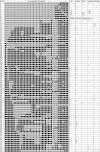Rapid detection of the Mycobacterium tuberculosis Beijing genotype and its ancient and modern sublineages by IS6110-based inverse PCR
- PMID: 16891502
- PMCID: PMC1594662
- DOI: 10.1128/JCM.00705-06
Rapid detection of the Mycobacterium tuberculosis Beijing genotype and its ancient and modern sublineages by IS6110-based inverse PCR
Abstract
The Mycobacterium tuberculosis Beijing genotype strains appear to be hypervirulent and associated with multidrug-resistant tuberculosis. Therefore, the development of a both rapid and simple method to detect the M. tuberculosis Beijing genotype is of clinical interest per se. Previously, we described a simple and fast approach to detect the Beijing genotype based on IS6110 inverse-PCR typing. Here, we evaluated this method against a large, diverse, and recent collection of strains. The study sample included 866 M. tuberculosis strains representing but not limited to the regions in Russia, Europe, and East Asia where the Beijing genotype is endemic. Based on a spoligotyping method, 408 strains were identified as Beijing genotypes; they were additionally subdivided into ancient and modern sublineages based on the analysis of the NTF locus. All strains were further subjected to the IS6110-based inverse PCR. All of the Beijing genotype strains were found to have identical two-band (ancient sublineage) or three-band (modern sublineage) profiles that were easily recognizable and distinct from the profiles of the non-Beijing strains. Therefore, we suggest using IS6110-based inverse-PCR typing for the correct identification of the Beijing genotype and its major sublineages. The method is fast and inexpensive and does not require additional experiments but instead is implemented in the routine typing method of M. tuberculosis.
Figures



Similar articles
-
Rapid detection of Mycobacterium tuberculosis Beijing genotype strains by real-time PCR.J Clin Microbiol. 2006 Feb;44(2):302-6. doi: 10.1128/JCM.44.2.302-306.2006. J Clin Microbiol. 2006. PMID: 16455874 Free PMC article.
-
Evaluation of new variable-number tandem-repeat systems for typing Mycobacterium tuberculosis with Beijing genotype isolates from Beijing, China.J Clin Microbiol. 2008 Mar;46(3):1045-9. doi: 10.1128/JCM.01869-07. Epub 2008 Jan 16. J Clin Microbiol. 2008. PMID: 18199785 Free PMC article.
-
[The identification of Mycobacterium tuberculosis isolates by DNA typing technique].Zhonghua Liu Xing Bing Xue Za Zhi. 2005 May;26(5):361-5. Zhonghua Liu Xing Bing Xue Za Zhi. 2005. PMID: 16053765 Chinese.
-
Possible underlying mechanisms for successful emergence of the Mycobacterium tuberculosis Beijing genotype strains.Lancet Infect Dis. 2010 Feb;10(2):103-11. doi: 10.1016/S1473-3099(09)70330-5. Lancet Infect Dis. 2010. PMID: 20113979 Review.
-
Mycobacterium tuberculosis phylogeography in the context of human migration and pathogen's pathobiology: Insights from Beijing and Ural families.Tuberculosis (Edinb). 2015 Jun;95 Suppl 1:S167-76. doi: 10.1016/j.tube.2015.02.031. Epub 2015 Feb 24. Tuberculosis (Edinb). 2015. PMID: 25754342 Review.
Cited by
-
Comparison of two molecular diagnostic methods for identifying Beijing genotype of Mycobacterium tuberculosis.Iran J Microbiol. 2020 Jun;12(3):209-215. Iran J Microbiol. 2020. PMID: 32685117 Free PMC article.
-
Using a multiplex polymerase chain reaction for the identification of Beijing strains of Mycobacterium tuberculosis.Eur J Clin Microbiol Infect Dis. 2009 Jan;28(1):105-7. doi: 10.1007/s10096-008-0590-7. Epub 2008 Jul 11. Eur J Clin Microbiol Infect Dis. 2009. PMID: 18618155
-
The genotypic population structure of Mycobacterium tuberculosis complex from Moroccan patients reveals a predominance of Euro-American lineages.PLoS One. 2012;7(10):e47113. doi: 10.1371/journal.pone.0047113. Epub 2012 Oct 15. PLoS One. 2012. PMID: 23077552 Free PMC article.
-
Investigation on Mycobacterium tuberculosis diversity in China and the origin of the Beijing clade.PLoS One. 2011;6(12):e29190. doi: 10.1371/journal.pone.0029190. Epub 2011 Dec 29. PLoS One. 2011. PMID: 22220207 Free PMC article.
-
Population structure dynamics of Mycobacterium tuberculosis Beijing strains during past decades in Japan.J Clin Microbiol. 2009 Oct;47(10):3340-3. doi: 10.1128/JCM.01061-09. Epub 2009 Aug 26. J Clin Microbiol. 2009. PMID: 19710282 Free PMC article.
References
-
- Bifani, P. J., B. Mathema, N. E. Kurepina, and B. N. Kreiswirth. 2002. Global dissemination of the Mycobacterium tuberculosis W-Beijing family strains. Trends Microbiol. 10:45-52. - PubMed
-
- Caminero, J. A., M. J. Pena, M. I. Campos-Herrero, J. C. Rodriguez, I. Garcia, P. Cabrera, C. Lafoz, S. Samper, H. Takiff, O. Afonso, J. M. Pavon, M. J. Torres, D. van Soolingen, D. A. Enarson, and C. Martin. 2001. Epidemiological evidence of the spread of a Mycobacterium tuberculosis strain of the Beijing genotype on Gran Canaria Island. Am. J. Respir. Crit. Care Med. 164:1165-1170. - PubMed
-
- Cox, H. S., T. Kubica, D. Doshetov, Y. Kebede, S. Rüsch-Gerdess, and S. Niemann. 2005. The Beijing genotype and drug-resistant tuberculosis in the Aral Sea region of Central Asia. Respir. Res. 6:134. [Online.] http://respiratory-research.com/content/6/1/134. - PMC - PubMed
-
- Dela, A., A. Sajduda, I. Pawlowska, and J. Dziadek. 2006. Molecular characterization of Mycobacterium tuberculosis isolates from Lodz, Poland: analysis by IS6110 restriction fragment length polymorphism and double-repetitive-element PCR. J. Infect. - PubMed
-
- Dragon, E. A., J. P. Spadoro, and R. Madej. 1993. Quality control of polymerase chain reaction, p. 160-168. In D. H. Persing, T. F. Smith, F. C. Tenover, and T. J. White (ed.), Diagnostic molecular microbiology. American Society for Microbiology, Washington, D.C.
Publication types
MeSH terms
Substances
LinkOut - more resources
Full Text Sources
Medical

